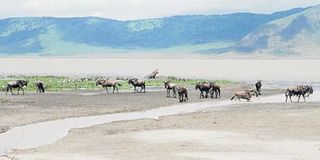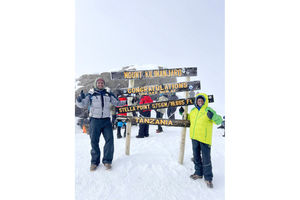Lifetime experience at Ruaha

What you need to know:
In a small group of three, we travelled from Arusha through Dodoma to Iringa Region. Our trip took two days because we did not want to drive after night fall. The sight of trucks, villagers walking and cycling along the road with their cargoes was amazing.
My friends and I recently embarked on a five-day tour to Ruaha National Park located in the south of Tanzania, about 130 km west of Iringa. The park is a favourite to those who have visited a few parks.
In a small group of three, we travelled from Arusha through Dodoma to Iringa Region. Our trip took two days because we did not want to drive after night fall. The sight of trucks, villagers walking and cycling along the road with their cargoes was amazing. So travelling anywhere is often a slow journey – all the more time to enjoy the very scenic countryside. We passed through Mikumi National Park where we saw some few wildlife such as baboons, giraffes, zebras, and gazelles just off the highway.
It was very exciting. We arrived in Iringa around 2 in the afternoon the following day and after we had lunch, we contemplated on whether or not to make the drive to Ruaha along a paved road. It was already 3pm and we were told it could take up to three hours to reach the park and so we had no reservations. We had to either risk getting a place before dark or wait until the following day.
We looked for divine guidance and then felt confident to begin the adventurous journey. We were all up for the challenge.
We were looking for a camp in our guidebook called Tungamalenga that was supposed to be situated about 35 km outside the park. We must have missed the sign and when we were about 30 km from the park gate we saw another sign to a lodge, the Sifa Safari Campsite, not suggested in our book, but which advertised tented bandas, flush toilets and hot showers.
This enticed us to investigate as it was almost 6pm and getting close to dark. On entering the gate, we were met by the manager who showed us his banda lodgings.
The solar-powered banda is a tent structure on a cement foundation with thatched roofing overtops. The lodging included ‘full board’ (breakfast, lunch and dinner). Well, things just seemed to be turning out in our favour as the accommodation was more than expected and our stay was perfect.
Dinner was served in an open dining banda lighted by lanterns as the solar battery had run out of power. The manager picked us at our banda and escorted us to the dining lodge.
The evening meal of beef stroganoff, a noodle dish, and rice vegetable was amazing considering the manager had to bring in his staff to keep an eye on us, the only guests that night. The meal concluded with a campfire under a million stars.
Breakfast the next morning included eggs, toast, fresh fruit, a wonderful cinnamon roll and lots of coffee. The manager was a wonderful host and we all agreed that we would recommend this place to anyone.
By 8 am we embarked again on our adventure into the park and drove to the Ruaha River Lodge, a place we had read about in our guidebook and which was recommended. It was rather upmarket and we were offered a discount as we planned to stay only one night. We thought the previous night’s accommodation was special but this was even more so.
These bandas were more elaborate – built of stones with thatched roofs and lots of screened windows. They were very large with amazing bathrooms, hot showers, flush toilets, sitting areas and verandas overlooking the almost dried up river that was visited regularly by lions, elephants, gazelle, and baboons. Lunch, dinner, and breakfast here were served in an open dining area.
While we had lunch just after our arrival, our host pointed out to two lionesses lounging under a shade tree across the river; our first experience being so close enough.
After lunch, we booked a game drive. Our vehicle was an open truck with a guide and a driver. We felt confident having two experienced guides in the exposed vehicle.
Like the rest of our trip, to this point the safari did not disappoint. We saw an amazing variety of animals, birds, and plant life with wonderful commentary along the way. The pictures highlight many of the animals, but actually being there close up with wildlife in their natural habitat was a lifetime experience, especially driving within five feet of a male lion under a tree and within 20 feet of a family of elephants resting their young under a shade tree.
We saw giraffe, many gazelles, African buffalo, banded mongoose, zebras, lizards, baboons, warthogs, hippos, crocodiles and lots of birds.
The bonus was spotting a leopard resting in a tree close to his kill (a gazelle) which was hanging much farther up in the tree. This whole area was very dry, except near the river, but our guide told us that during the rainy season it is normally lush and green.
We look forward to coming back during the rainy season to see the contrast. It was over far too soon, and we returned just after 6:30 completely enthralled with our experience.
Like the night before, we were escorted to dinner and back to our bandas for our own safety as the animals roam around the campsite in the evenings. This time our escort was a Maasai warrior in full regalia, holding a spear in his hand. He spoke English very well and we discovered he was also a guide for this lodge – a versatile Maasai.
The next morning at breakfast, there was a buzz about a lioness that had roamed around the camp during the night. I had heard what I thought was an elephant close by, but it must have been the lioness. We then understood why we had been warned against leaving our bandas after night fall.




